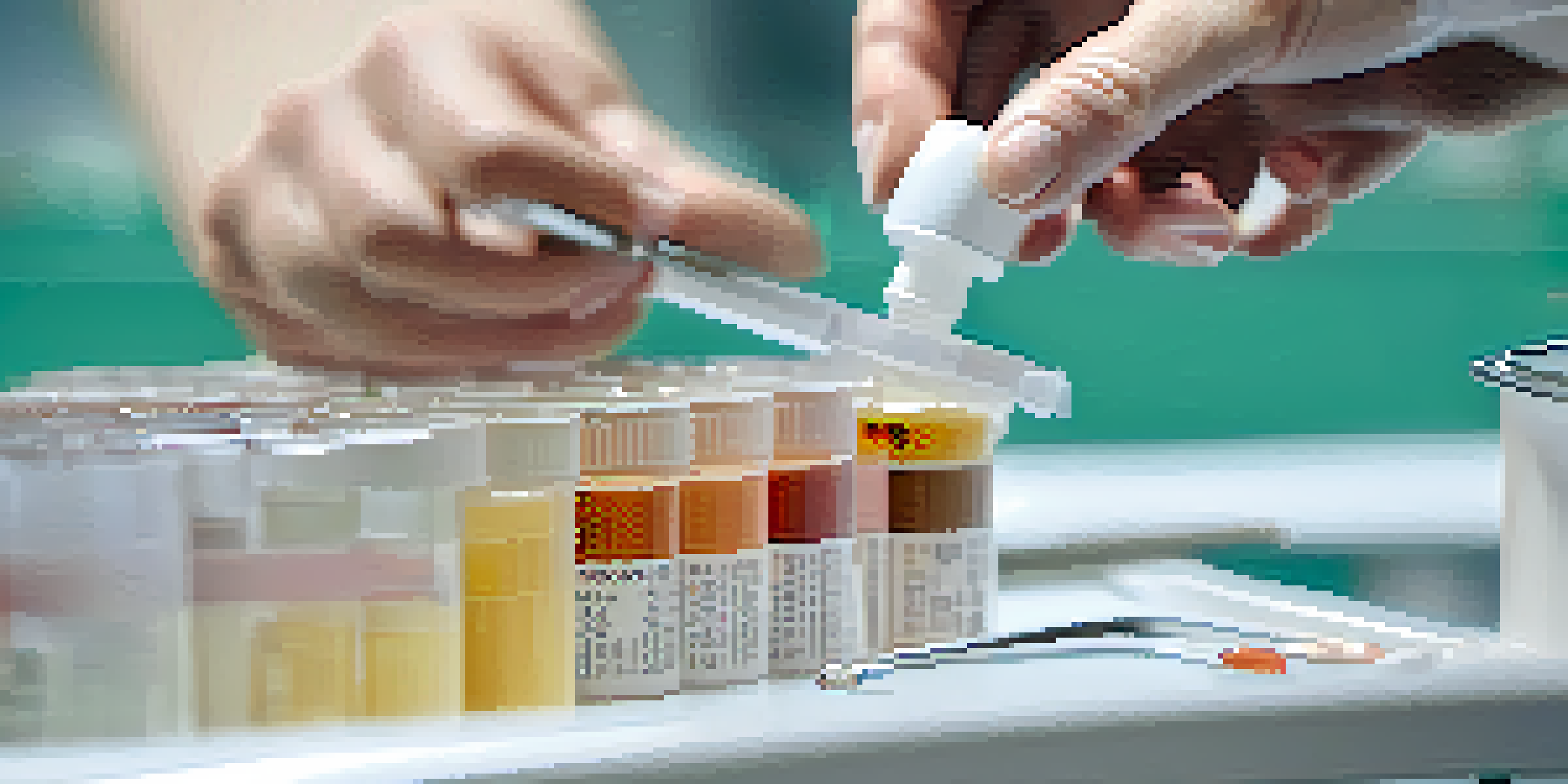Understanding Food Allergy Testing: Types and Procedures Explained

What Are Food Allergies and Their Symptoms?
Food allergies occur when the immune system mistakenly identifies a harmless food protein as a threat. This can lead to a range of symptoms, from mild reactions like hives and stomach upset to severe issues such as anaphylaxis, which can be life-threatening. Understanding these symptoms is vital for early detection and management.
Allergies are a response of the immune system, and understanding them is key to managing your health.
Common allergens include nuts, dairy, shellfish, and wheat, and each person may react differently. For instance, one individual might experience itching while another might face respiratory issues. Recognizing these symptoms can help in seeking timely medical advice.
If you suspect you or someone you know has a food allergy, it’s important to consult a healthcare provider. Early diagnosis can lead to better management strategies and improved quality of life for those affected.
The Importance of Food Allergy Testing
Food allergy testing is crucial for accurately diagnosing allergies and determining which foods to avoid. This testing not only helps prevent allergic reactions but also aids in creating a personalized diet plan. For many, understanding their specific allergies can significantly enhance their daily life.

Without proper testing, individuals may mistakenly eliminate foods that are safe, leading to unnecessary dietary restrictions. This can result in nutritional deficiencies and a limited lifestyle. Comprehensive testing enables a balanced approach to managing allergies.
Understanding Food Allergies
Food allergies occur when the immune system misidentifies harmless proteins, leading to various symptoms that require early detection.
Moreover, accurate testing can identify cross-reactive foods, which share similar proteins with known allergens. This knowledge allows individuals to navigate their diets more safely and confidently.
Types of Food Allergy Tests Available
There are several types of food allergy tests available, each with its unique approach. The most common tests include skin prick tests, blood tests, and oral food challenges. Understanding these options can help you choose the right method for your situation.
Food allergies may be common, but they can also be life-threatening. Awareness and proper testing are essential.
Skin prick tests involve placing small amounts of allergens on the skin and observing for reactions. Blood tests measure specific antibodies that indicate an allergic response. Both methods have their pros and cons, so discussing them with a healthcare provider is essential.
Oral food challenges are considered the gold standard for diagnosing food allergies. During this test, a patient consumes a suspected food under medical supervision to monitor for reactions. This method is particularly useful when other tests yield inconclusive results.
Skin Prick Test: What to Expect
The skin prick test is a straightforward and widely used method to diagnose food allergies. During the test, a healthcare professional places a drop of allergen extract on the skin and lightly pricks the area. This allows the allergen to enter the skin and trigger a reaction if an allergy is present.
Results are typically visible within 15-20 minutes, with swelling or redness indicating a potential allergy. While this test is generally safe, it may cause minor discomfort, similar to a mosquito bite. It's important to follow any pre-test instructions provided by your healthcare provider.
Importance of Allergy Testing
Accurate food allergy testing is essential for identifying allergens, preventing reactions, and developing personalized dietary plans.
However, skin prick tests may not be suitable for everyone, particularly those with severe eczema or certain medications. Discussing your medical history with your doctor will help determine if this test is appropriate for you.
Blood Tests: How They Work
Blood tests for food allergies measure the presence of specific IgE antibodies in the blood. When you consume a food you’re allergic to, your immune system produces these antibodies as a response. The test helps quantify the level of these antibodies, providing insight into the severity of an allergy.
The most common blood test is the ImmunoCAP test, which can test for multiple allergens at once. This method is beneficial for individuals who may have skin conditions that preclude them from a skin prick test. Results usually take a few days to a week, allowing for thorough analysis.
While blood tests are helpful, they are not definitive. A positive result may indicate an allergy, but it could also reflect sensitivity to the food. Therefore, it is often recommended to combine blood tests with other diagnostic methods for a comprehensive understanding.
Oral Food Challenges: The Gold Standard
Oral food challenges are considered the most reliable method for diagnosing food allergies. During this procedure, a patient consumes small amounts of the suspected allergen in a controlled environment, typically a clinic or hospital. This allows healthcare providers to monitor for any adverse reactions closely.
The challenge is conducted under strict supervision to ensure immediate medical intervention if a severe reaction occurs. This method not only confirms the presence of an allergy but can also determine the threshold amount that can be tolerated, which is invaluable for management.
Managing Allergies Post-Testing
After testing, managing food allergies involves avoiding allergens, educating oneself about food labels, and possibly carrying emergency medications.
While oral food challenges provide clear answers, they may cause anxiety for some individuals. Preparation and support from healthcare professionals can help ease concerns, making it a manageable experience.
Next Steps After Testing: Managing Food Allergies
Once food allergy testing is complete, the next step is management. This typically involves avoiding identified allergens, which can be daunting but is crucial for safety. Many find it helpful to consult with a dietitian to create a balanced meal plan that avoids allergens while ensuring nutritional needs are met.
Education is another key component; understanding how to read food labels and recognize hidden allergens is essential. Many products contain allergens in unexpected forms, so this knowledge empowers individuals to make safe choices. It’s also important to communicate dietary restrictions to family, friends, and restaurants.

In some cases, individuals may be prescribed medications such as antihistamines or an epinephrine auto-injector for emergencies. Being prepared can significantly reduce the risk of severe reactions and help individuals feel more secure in their daily lives.